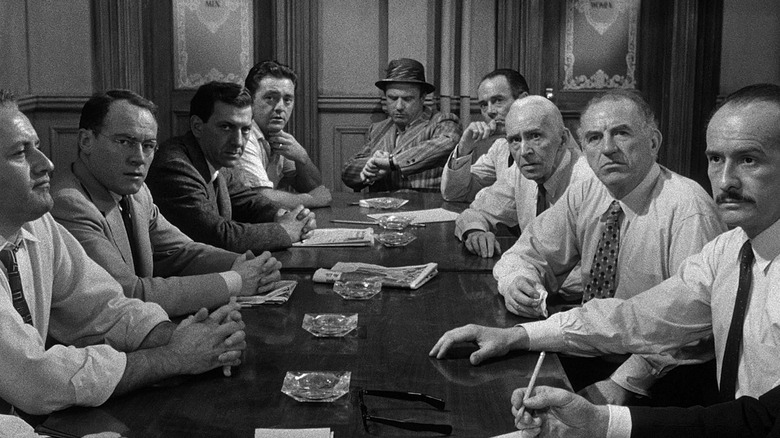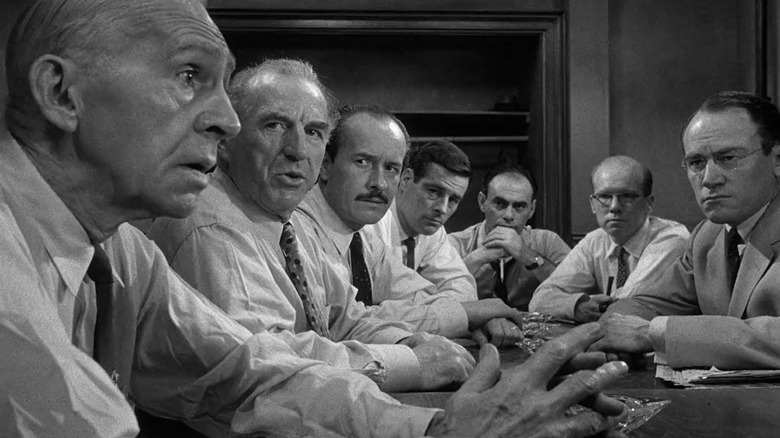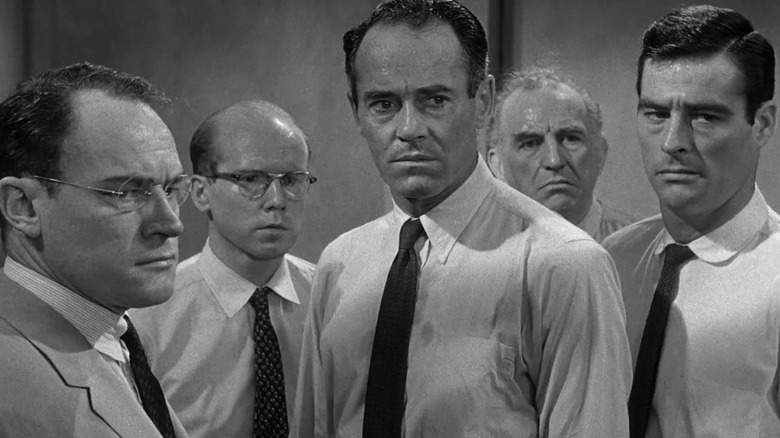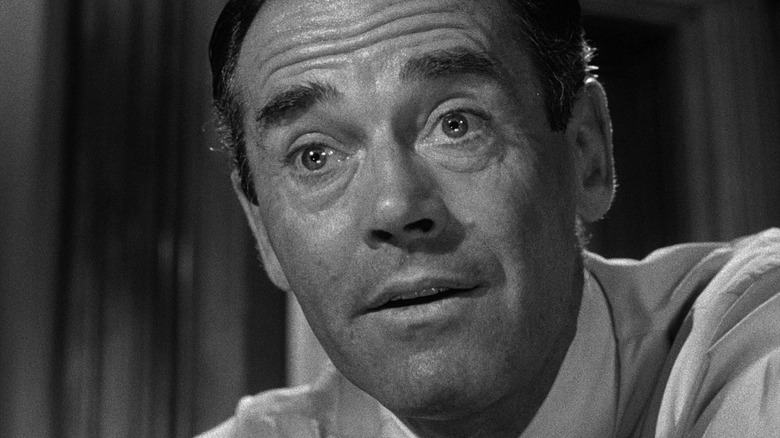One Of 12 Angry Men's First Shots Was More Complex Than You Think
Sidney Lumet's seminal 1957 classic "12 Angry Men" — required viewing for any American citizen who finds themselves called to sit on a jury — remains as salient and immediate today as it did 65 years ago. Bare-bones and visually simple, "12 Angry Men" takes place almost entirely in a jurors' deliberation room as the titular men argue as to reasonable doubt in their murder case. Seemingly open-and-shut, all but one of the jurors immediately votes to convict — and execute — the suspect. One juror (Henry Fonda) feels that they, morally, need to be more careful in a death penalty case and votes to exonerate. The jurors spend the film addressing each detail of their case piece by piece, eventually finding reasonable doubt in all of them. In so doing, they each examine their unspoken prejudices and the quality of their own characters.
Seriously, watch "12 Angry Men." It's for rent on various video-on-demand platforms.
In terms of cinematic visual dynamism, "12 Angry Men" seems to be one of the simplest imaginable; A small crowded room would only allow for a limited number of camera angles for cinematographer Boris Kaufman ("On the Waterfront," "Baby Doll"). Lumet takes what appears — at least at first — to be a mere practical approach to the material. The filmmakers focus on the actors, using close-ups on the people talking, cutting to wide angles when the whole room is reacting to an address or speech.
There was, however, one seemingly simple shot right at the head of "12 Angry Men" that was, in fact, massively complicated to pull off. Sidney Lumet's seminal filmmaking book "Making Movies" (which is quoted extensively on Cinephilia & Beyond) details the process of constructing an unbroken eight-minute take that introduces the film.
The eight-minute shot
The opening shot of the jurors' deliberation room in "12 Angry Men" is an eight-minute take wherein all the title characters file in, mill about, chat amongst themselves, and eventually find their seats. No major information is revealed in this scene, and the actors communicate only general things about their characters. Old man. Polite man. Shy man, etc. Lumet recalls the experience, going into each one of the camera and lighting setups. While it may not seem like it, the entire sequence required a crane and half a say to set up.
"One of the most complex lighting jobs was the first shot inside the jury room in '12 Angry Men.' The shot lasts almost eight minutes. We meet all twelve jurors. The shot starts over the fan, which will matter later in the movie, and at one point or another moves into at least a medium shot of each person. I did it on a crane. The base of the crane (the dolly) had thirteen different positions moving in and about the small set. The arm (the boom) on which the camera sat had eleven different positions left and right and eight different positions up and down. Boris Kaufman needed seven hours to light the shot. We got it on Take 4."
One can picture the frustration on set after the failure of take number three!
It's worth remembering that in 1957, typical 35mm cinema cameras were still massive machines that could not be carried. The Steadicam — the device that could strap a camera to a camera operator and keep it relatively steady, making for "walking shots" — wasn't used in a major motion picture until 1975's "Bound for Glory." To give credit: The Steadicam was invented by Garrett Brown.
Moving walls
Lumet also describes the process of moving walls to get the shots he needed. The jurors' deliberation room was a constructed set, and Lumet had to move walls and ceilings to fit the camera inside. In "Making Movies," Lumet goes on a long tear about how difficult it was to move those walls — a construction crew was needed each time, and they reused curtains and wall-hangings — and what a time suck it turned out to be. Lumet, with utter clarity, recalls just how he tired to block out the cast and crew's working schedules, and even the kinds of food and drink he consumed on the set to stay sharp (coffee was out, bagels were in).
"If I'm going to make a big turnaround, going from wall A to wall C, I try to time it for the lunch hour. Generally, the construction crew (four grips, two carpenters) go to lunch an hour earlier than we do. By the time we break, anywhere between 11:30 and 1:30, they're already back and can make the changeover. They put wall C back and pull out wall A. It's more complicated than it sounds. Everything has to move — chairs, makeup tables, sound boom, camera dolly; the dressing (curtains, shelves, pictures, et cetera) comes down off wall A and has to be put back up on wall C."
Then — and, seriously, filmmakers have to consider this sort of thing — cleanup and meals are timed into the day
"The paint, plaster, or wallpaper on the walls gets damaged from constant movement and has to be repaired. If ceiling pieces are being moved, the old ones have to be removed and new ones put in. The floor becomes filthy during shooting and has to be swept."
Choreography
With 12 actors and a tiny, tiny set that was a pain to constantly move and reconstruct, Lumet had another major challenge: The simple art of blocking. The actors couldn't merely walk where they might, but had to be carefully choreographed during their scenes. What looks incidental was, in fact, a massive process of figuring out marks, using stand-ins, and assuring that actors go where they are told (a scene in Tom DiCillo's wonderful 1995 filmmaking drama "Living in Oblivion" shows how annoying it is when an actor, on a whim, merely walks away from a window):
"With the walls moved, it's time for a new setup. The actors are called. They are usually out of costume, and their makeup needs repair from whatever they did during lunch hour. We start by walking through the new shot. Again I tell them not to work full out. We make sure all props are placed. Then, with stand-ins watching carefully, we go through the shot again, only this time for camera. I've chosen the lens and actually watch the scene, operating the camera myself."
Then, once the blocking is done, everything is marked, and the actors can finally prepare for the scene. It's the afternoon by then.
Oh my, what a headache. If one can make a film as good as "12 Angry Men," however, it's worth it. And if one aims to be a filmmaker as good as Lumet, one would do well to ready his book. The details are down-to-earth and practical and acknowledge the overwhelming technicals that go in to making art. Just make sure everyone's making the same movie, and all should be well.



